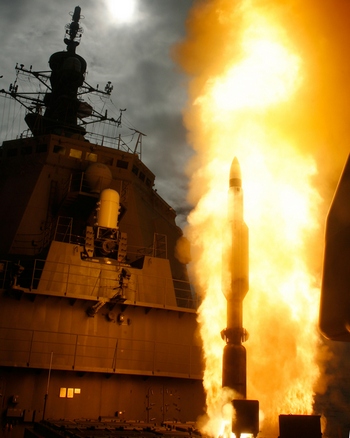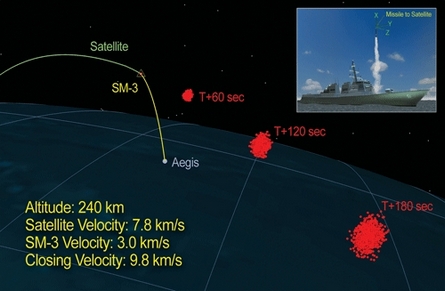A missile fired from a US Navy warship in the Pacific has intercepted a crippled spy satellite at the first attempt. The spacecraft was scheduled to reenter the atmosphere within days, posing a danger from its unused rocket fuel.
The US Department of Defense says "a network of land-, air-, sea- and spaced-based sensors confirms that the US military intercepted a non-functioning National Reconnaissance Office satellite which was in its final orbits before entering the earth's atmosphere."
US plans to shoot down the classified imaging satellite, which malfunctioned immediately after its launch in December 2006, were attacked by Russia and China as a thinly veiled exercise to demonstrate the anti-satellite capabilities of the DoD's missile defence system.
At approximately 10:26pm EST on 20 February, the Aegis cruiser USS Lake Erie fired a single modified Standard SM-3 missile, hitting the satellite approximately 247km (133nm) over the Pacific Ocean. Two other similarly armed warships, USS Decatur and USS Russell, were standing by to take shots.

© US Navy
The DoD's objective was to rupture the satellite's fuel tank and dissipate the roughly 1,000lb (450kg) of highly toxic hydrazine fuel before it entered the atmosphere. "Confirmation that the fuel tank has been fragmented should be available within 24 hours," the Pentagon says in a statement.
Because of the satellite's relatively low altitude, debris was expected begin re-entering the atmosphere immediately. "Nearly all of the debris will burn up on reentry within 24-48h and the remaining debris should re-enter within 40 days," says the DoD.
Based on information released before the intercept, US company Analytical Graphics produced a simulation of the shootdown and subsequent debris. Video and graphics from the simulation, such as the one below, can be seen at AGI's website.

© Analytical Graphics
Source: FlightGlobal.com




















